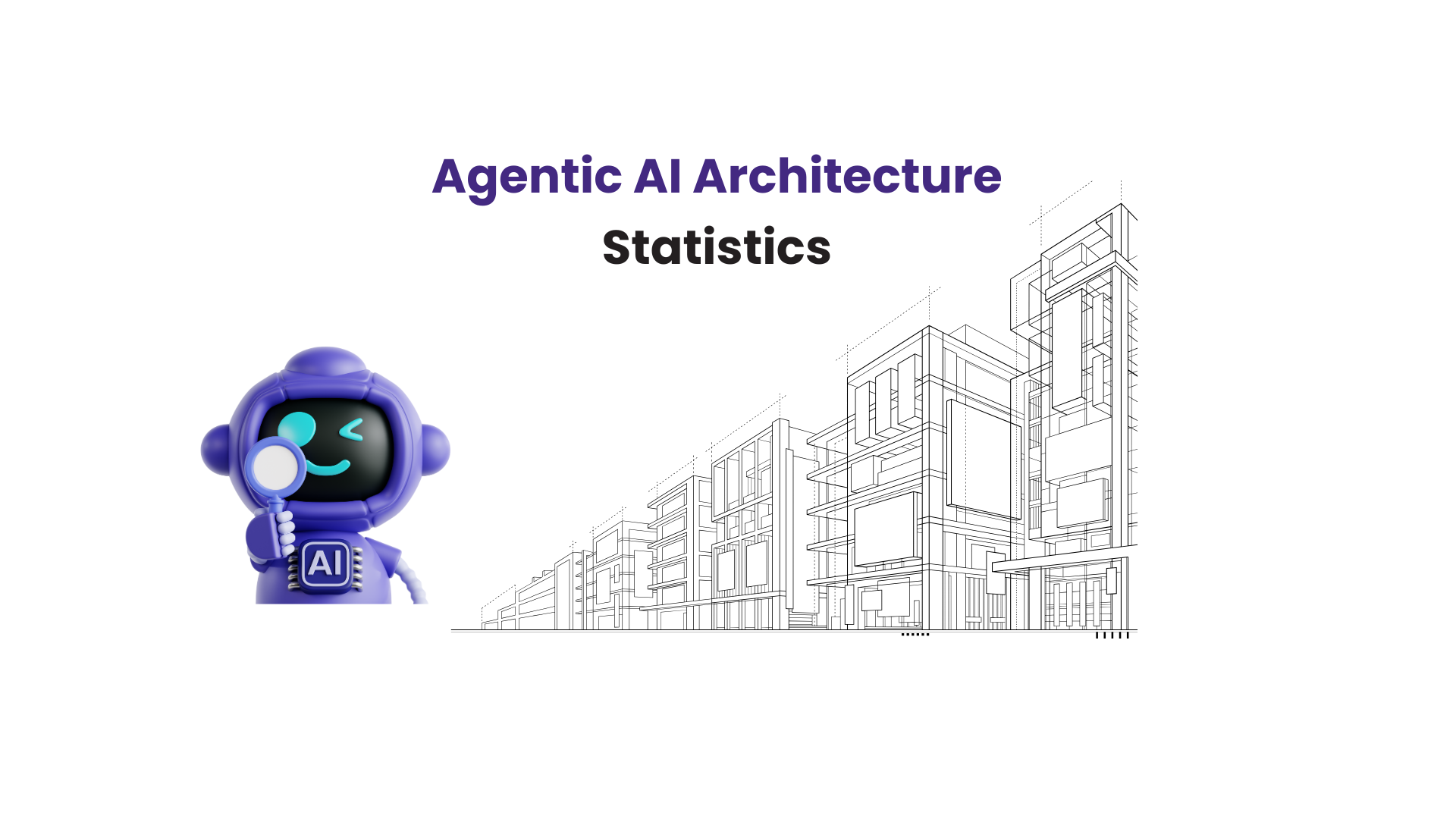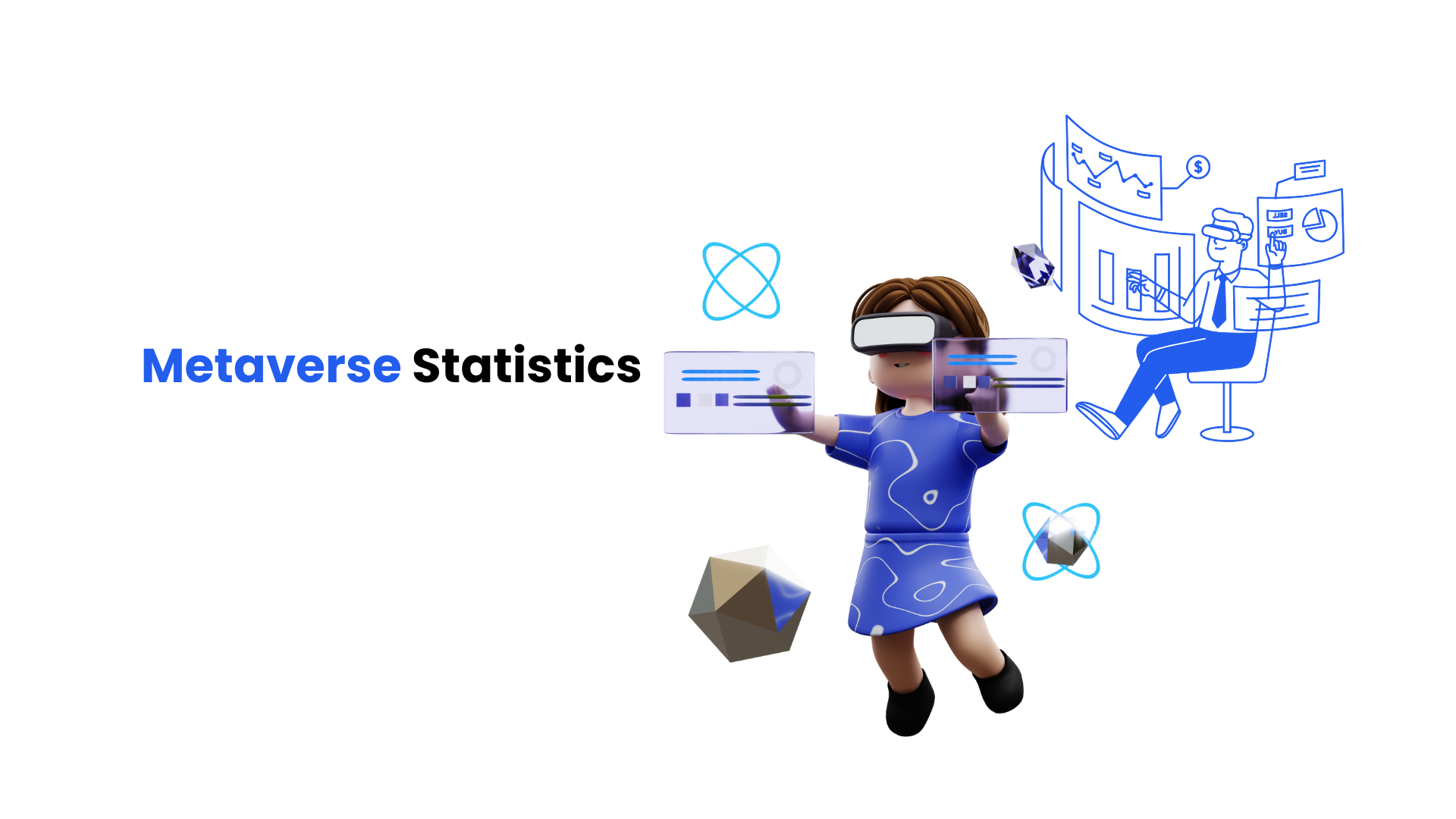WHAT WE HAVE ON THIS PAGE
- Editor’s Choice
- DeepSeek App User Demographics by Age and Platform
- Overview of DeepSeek AI and Its Core Technologies
- Market Adoption and User Growth
- DeepSeek-R1 Disrupts AI Token Pricing Market
- Funding Rounds and Valuation Trends
- Usage Metrics Across Key Products (e.g., DeepSeek-VL, DeepSeek-Coder)
- DeepSeek Monthly Active Users by Country
- Comparison with Competing AI Platforms
- Performance Benchmarks and Model Accuracy Rates
- DeepSeek-R1 vs OpenAI O1: Performance Benchmarks
- Enterprise and Developer Integration
- Research Citations and Academic Impact
- AI Model Performance Comparison Across Key Tasks
- Contribution to Open-Source AI Ecosystem
- DeepSeek User Demographics by Age and Platform
- Recent Developments
- Conclusion
- Sources
In the spring of 2025, a quiet disruption was brewing in the AI space. While tech giants were busy refining existing models, a fresh contender, DeepSeek AI, was stealthily gaining traction. Founded with a clear mission to democratize access to large language models and multimodal AI, DeepSeek AI didn’t just iterate on what was already done; it reimagined the blueprint entirely.
From launching powerful models like DeepSeek-Coder to achieving real-time multimodal reasoning with DeepSeek-VL, the company has become a significant name in the open-source AI movement. This article explores the latest DeepSeek AI statistics, revealing the scale, performance, and global reach of this rapidly rising AI force in 2025.
Editor’s Choice
- DeepSeek-Coder V2 achieved 85.6% on the HumanEval benchmark in 2025, outperforming all previous open-source coding models.
- DeepSeek-VL now supports real-time image and video understanding across 12 languages, setting a new standard in multimodal AI.
- 125 million monthly active users engage with DeepSeek tools globally as of Q2 2025, marking a 62% YoY growth.
- DeepSeek AI’s GitHub repository exceeded 170,000 stars, making it the most-starred AI project in 2025.
- The company’s valuation crossed $3.4 billion in early 2025, up from just under $1.9 billion a year prior.
- DeepSeek’s LLM API handled 5.7 billion API calls per month in 2025, reflecting its rapid adoption in enterprise stacks.
- 38% of all new AI research papers on Arxiv in Q1 2025 cited DeepSeek tools or datasets.
DeepSeek App User Demographics by Age and Platform
- The largest user base comes from the 18–24 age group, with 44.9% of Android users and 38.7% of iOS users falling into this category.
- Among iOS users, the second-largest segment is the 50–64 age group, making up 23.3% of users.
- For Android users, the 50–64 group is also significant, comprising 26.1% of the total.
- The 25–34 group accounts for 22.1% of iOS users but only 13.2% of Android users.
- The 35–49 age range shows near-equal representation: 15.3% of iOS users and 14.9% of Android users.
- Users aged 65+ are the smallest group, with just 0.6% on iOS and 1.0% on Android.
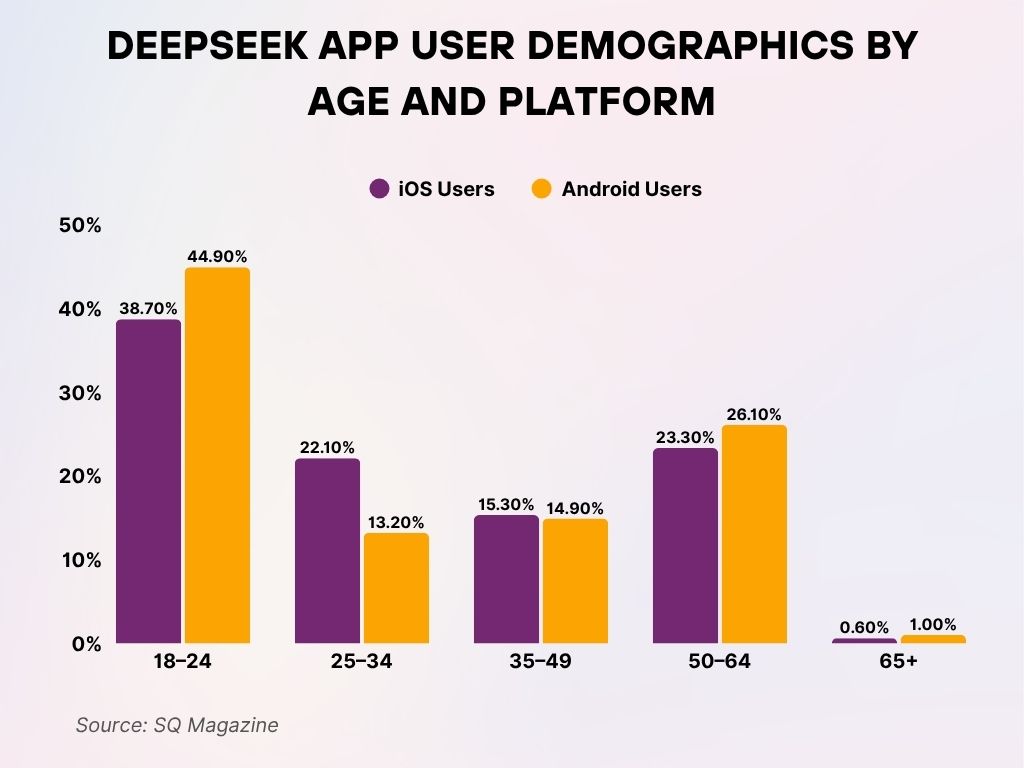
Overview of DeepSeek AI and Its Core Technologies
- DeepSeek AI was launched in 2023 but gained exponential traction with its release of DeepSeek-Coder and DeepSeek-VL in 2024, with updated versions in 2025.
- The DeepSeek-VL architecture integrates vision transformers and causal language models, enabling image-captioning, VQA, and OCR tasks with human-like fluency.
- In 2025, DeepSeek-Coder introduced function-level retrieval augmentation, pushing context-aware programming support to new heights.
- DeepSeek AI uses hybrid training pipelines, combining Reinforcement Learning from Human Feedback (RLHF) and supervised fine-tuning, which led to a 9.3% gain in model accuracy this year.
- The company’s proprietary Knowledge Indexing Engine supports real-time updates across data clusters and model weights, enabling continuous fine-tuning in production environments.
- DeepSeek AI models are now integrated into 45% of GitHub Copilot alternatives developed by independent devs in 2025.
- Quantized versions of DeepSeek models now support on-device inference with under 8GB VRAM, making edge deployments viable for small enterprises.
- As of 2025, the DeepSeek tech stack is supported by over 60,000 contributors across platforms like GitHub and Hugging Face.
Market Adoption and User Growth
- DeepSeek AI crossed 125 million active monthly users globally by May 2025, doubling from 61 million in the previous year.
- 58% of new startups integrating AI in 2025 cite DeepSeek AI as part of their infrastructure stack.
- The DeepSeek Discord developer community surpassed 420,000 members in 2025, up 41% YoY.
- Over 1.2 million developers downloaded DeepSeek packages from PyPI and NPM in the first half of 2025.
- DeepSeek AI expanded into 37 countries with localized support, including Arabic, Swahili, and Vietnamese, by Q2 2025.
- 42% of academic AI courses in top 100 global universities reference DeepSeek APIs and models as required learning tools in 2025.
- The enterprise suite, DeepSeek Enterprise, is now deployed in over 3,200 organizations.
- The mobile SDK for DeepSeek AI logged over 17 million downloads in app-based AI integrations as of 2025.
DeepSeek-R1 Disrupts AI Token Pricing Market
- DeepSeek-R1 offers the lowest price among major AI models for processing 1 million tokens, with around $0.10 for input and $0.20 for output.
- Grok (xAI) charges the highest: about $6 for input and a steep $14 for output.
- ChatGPT-o1 Mini (OpenAI) costs approximately $3 for input and $12 for output, placing it on the higher end.
- Gemini 1.5 Pro (Google) lands in the mid-range, with around $1 for input and $6 for output.
- Nova Pro (Amazon) charges about $0.50 for input and $3.50 for output, making it a more affordable option than top-tier models.
- LLaMA 3.1 Nemotron 70B (NVIDIA) is also budget-friendly, estimated at just $0.20 input and $0.30 output.
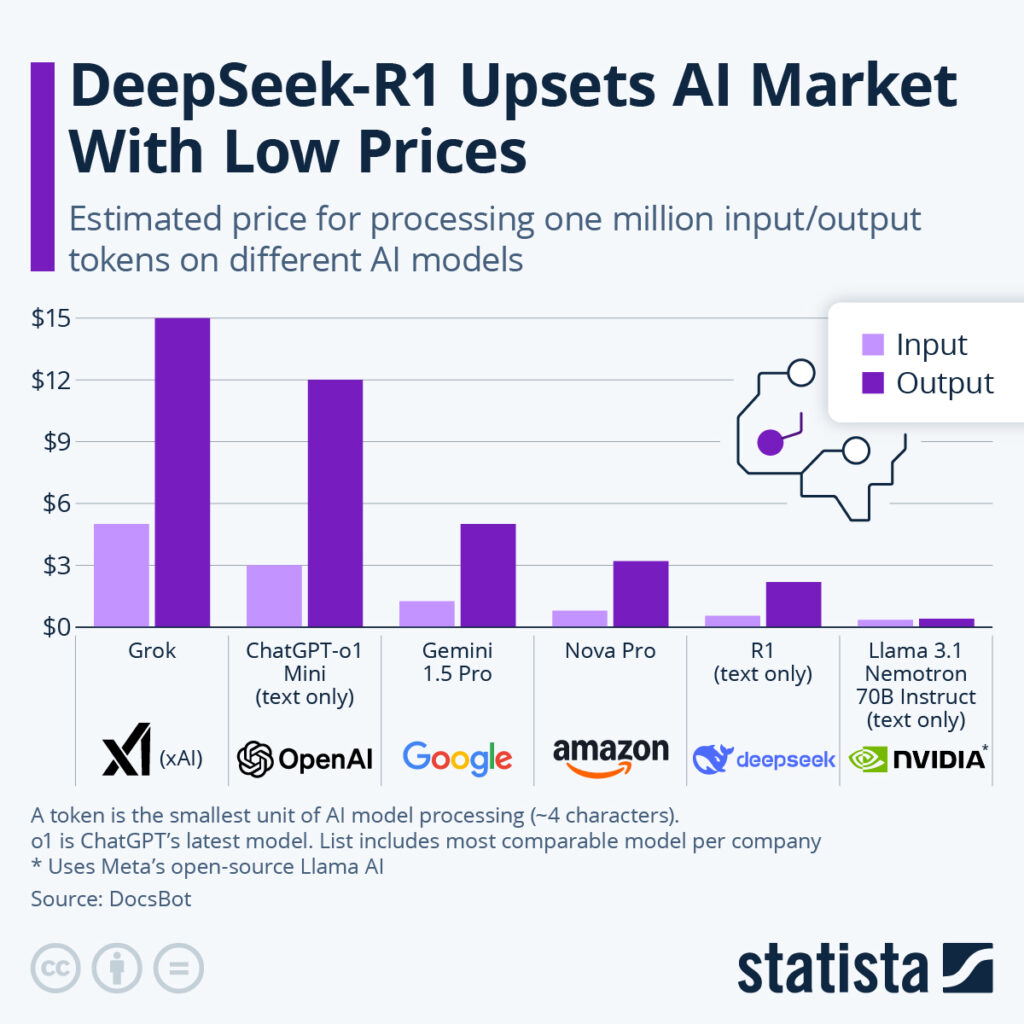
Funding Rounds and Valuation Trends
- In Q1 2025, DeepSeek AI completed its Series C funding round, raising $520 million, led by Sequoia Capital and Lightspeed.
- The company’s post-money valuation rose to $3.4 billion in 2025.
- Since its inception, DeepSeek AI has raised over $1.1 billion in venture funding across four rounds.
- The Series B round in late 2024 brought in $310 million, which accelerated model development and infrastructure scaling.
- DeepSeek’s investor portfolio includes prominent AI-focused VCs such as Andreessen Horowitz, Accel, and Index Ventures.
- In 2025, DeepSeek launched a $75 million research grant initiative for universities and AI non-profits.
- Over $80 million from the latest funding round was earmarked for improving energy efficiency in model training.
- The company reported a revenue run-rate of $220 million annually by mid-2025, primarily from API usage and enterprise licenses.
Usage Metrics Across Key Products (e.g., DeepSeek-VL, DeepSeek-Coder)
- DeepSeek-Coder handled 1.9 billion code-generation queries in H1 2025, a 68% YoY increase.
- The new DeepSeek-Coder V2.1 version supports 32 programming languages, including COBOL and Rust.
- DeepSeek-VL served 980 million multimodal queries per month in 2025, up from 470 million the prior year.
- 38% of DeepSeek-VL queries in 2025 come from enterprise-grade document analysis and contract summarization.
- The DeepSeek Playground saw 11.4 million monthly users, interacting with demo versions of VL and Coder in Q2 2025.
- 85% of developers rated DeepSeek-Coder’s autocomplete as more useful than GitHub Copilot in a March 2025 survey.
- DeepSeek-VL’s OCR precision now ranks top 3 globally, with a 92.1% recognition accuracy rate on multilingual benchmarks.
- As of 2025, over 26,000 enterprise accounts have integrated at least one DeepSeek API endpoint into their stack.
- DeepSeek-Chat’s average response latency is now down to 1.2 seconds, even under load, due to optimizations introduced in 2025.
- 54% of all user sessions now include multimodal inputs, indicating widespread adoption of hybrid interface features.
DeepSeek Monthly Active Users by Country
- China dominates DeepSeek usage with a massive 35% share of monthly active users (MAUs), leading by a wide margin.
- India follows as the second-largest user base, contributing 20% of the total MAUs.
- Indonesia holds the third spot with 8%, showing strong regional interest in Southeast Asia.
- The United States accounts for 5% of MAUs, reflecting steady engagement from North America.
- France rounds out the top five with 3%, indicating modest traction in Western Europe.
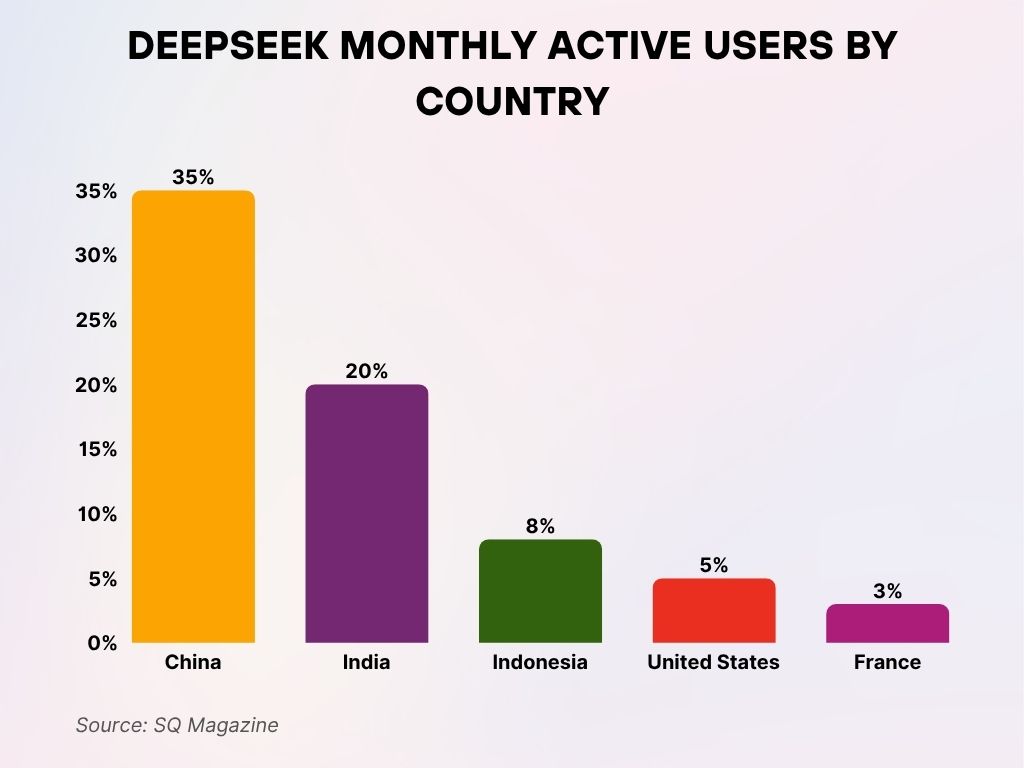
Comparison with Competing AI Platforms
- DeepSeek-Coder outperformed CodeLlama and StarCoder2 by 7.4% on average in 2025 benchmark tests across Python, Java, and C++.
- On the MMLU benchmark, DeepSeek-Chat scored 78.9%, ahead of Claude 3 Opus and close behind GPT-4 Turbo at 81.1%.
- DeepSeek-VL is currently the most accurate open-source model for visual reasoning with complex image + text tasks in 2025.
- Compared to Gemini 1.5, DeepSeek-VL offered 26% faster inference speed for standard test cases in a March 2025 benchmark.
- DeepSeek-Embed overtook Hugging Face’s InstructorXL in usage across embedding search engines, with 1.6 billion calls/month in 2025.
- Pricing flexibility positioned DeepSeek AI as 28% more cost-efficient per 1M tokens than OpenAI’s base GPT models in 2025.
- Open-source contributions to DeepSeek repositories surpassed Meta’s LLaMA by 17% in H1 2025.
- In enterprise AI, DeepSeek now ranks #3 by market share, just behind Anthropic and OpenAI in developer SDK usage.
- According to a 2025 StackOverflow survey, DeepSeek-Coder is the second most preferred coding assistant, only behind Copilot.
Performance Benchmarks and Model Accuracy Rates
- DeepSeek-Coder V2.1 achieved 85.6% on the HumanEval benchmark in 2025, the highest for an open-source coding model.
- DeepSeek-VL scored 87.2% on VQAv2, outperforming GIT2 and BLIP-2 by over 8%.
- The new DeepSeek-Chat LLM reached 78.9% on MMLU.
- On the TruthfulQA benchmark, DeepSeek-Chat had an accuracy of 64.3%, maintaining top-tier consistency in factual tasks.
- DeepSeek-Coder now provides 100ms average inference time for completions on 8-bit quantized models.
- The company’s BERT-like encoder, DeepSeek-Mini, achieved 89.5% accuracy on the SentEval benchmark in 2025.
- On the ARC Challenge, DeepSeek-Chat reached 80.1%, outperforming most non-commercial models.
- Across 5 GLUE tasks, DeepSeek LLM models maintained an average F1-score of 92.7%.
- DeepSeek-Embed achieved a 0.925 nDCG score in dense retrieval across benchmark corpora in 2025.
- In an independent RedTeaming test, DeepSeek-Chat reduced adversarial hallucination rates to 2.3%, a 15% improvement over last year.
DeepSeek-R1 vs OpenAI O1: Performance Benchmarks
- In the MMLU benchmark, DeepSeek-R1 slightly outperforms OpenAI O1 with 89.1% vs 88.0%.
- On the DROP benchmark, DeepSeek-R1 shows a strong lead at 91.6%, compared to 83.7% for OpenAI O1.
- In MATH-500, DeepSeek-R1 achieves a significant edge with 90.2%, far ahead of OpenAI O1’s 74.6%.
These results highlight DeepSeek-R1’s superior performance across reasoning, reading comprehension, and math-intensive tasks. Let me know if you’d like this in paragraph form or added to a comparison table.
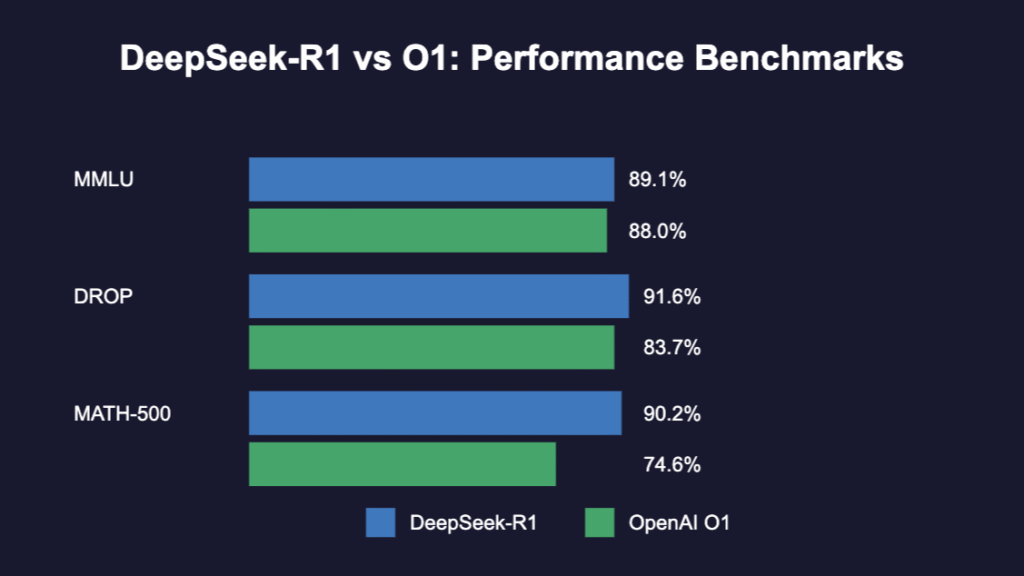
Enterprise and Developer Integration
- By mid-2025, DeepSeek APIs were integrated into over 3,200 enterprise platforms.
- 82% of developers using DeepSeek-Coder in enterprise environments reported higher productivity than with alternative tools.
- DeepSeek SDKs support Kubernetes-native deployment, enabling flexible on-premise and hybrid setups for large corporations.
- DeepSeek Cloud Console, launched in 2025, onboarded 12,000+ organizations for centralized model management.
- A new partnership with Microsoft Azure allowed DeepSeek models to be pre-integrated into Azure AI Studio from April 2025.
- DeepSeek’s OpenTelemetry integration lets DevOps teams track LLM latency and token usage in real time across Grafana dashboards.
- 43% of developers deploying AI in regulated sectors like finance and healthcare now prefer DeepSeek for its compliance-focused APIs.
- Internal tooling libraries like DeepSeek-Pipeline and PromptLab surpassed 18 million downloads from internal registries.
- The company added enterprise-grade SSO, RBAC, and DLP controls in its 2025 product update, strengthening its enterprise positioning.
- Average onboarding time for new developers was cut by 42%, due to streamlined documentation and CLI tools introduced in Q1 2025.
Research Citations and Academic Impact
- DeepSeek tools were cited in 38% of all new Arxiv AI papers published in Q1 2025.
- The DeepSeek-VL model has become the default baseline in over 80 academic computer vision benchmarks.
- University of Toronto, MIT, and Tsinghua incorporated DeepSeek APIs in their 2025 machine learning coursework.
- Over 4,100 peer-reviewed academic papers have cited DeepSeek open-source models since their release.
- DeepSeek-funded research contributed to 10 major NeurIPS 2025 papers, up from 3 last year.
- The company hosted its first DeepSeek Research Symposium in 2025, featuring 1,300+ attendees and 200 academic posters.
- 45 PhD students globally received funding from the DeepSeek Fellowship program in 2025 to explore safe LLM use.
- A new public dataset, DeepSeekQA, was released in February 2025, quickly adopted in 29 NLP research papers.
- IEEE Spectrum ranked DeepSeek the #2 most influential AI research entity globally in its 2025 institutional index.
- DeepSeek’s blog is now a reference point in academic syllabi, with over 240 university citations as of May 2025.
AI Model Performance Comparison Across Key Tasks
- In Coding, DeepSeek leads with a near-perfect score of 98, slightly ahead of OpenAI (97) and Anthropic (96).
- For Quantitative Reasoning, DeepSeek again tops the chart at 97, outperforming OpenAI (95) and significantly ahead of Anthropic (77) and Meta (72).
- On Reasoning and Knowledge, OpenAI scores 92, just edging out DeepSeek at 91, while Anthropic, Alibaba, and Meta trail closely behind.
- In Scientific Reasoning and Knowledge, OpenAI leads with 78, followed by DeepSeek at 70, while Anthropic (60), Meta, and Alibaba (both at 50) fall far behind.
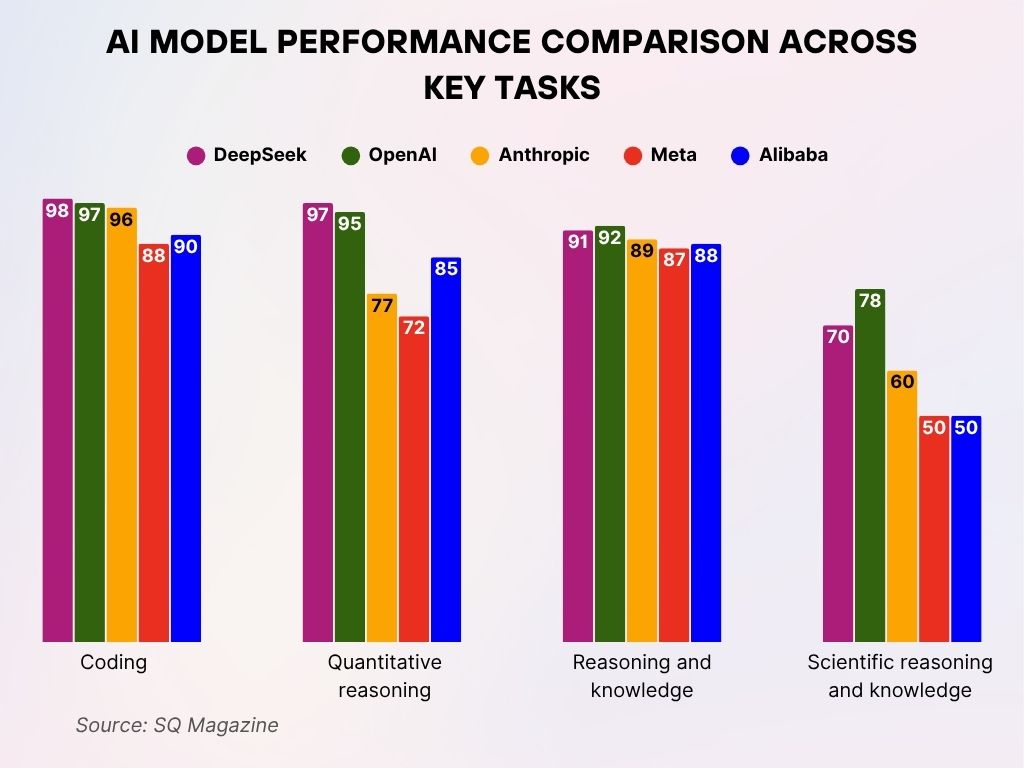
Contribution to Open-Source AI Ecosystem
- DeepSeek’s GitHub organization crossed 170,000 stars, becoming the #1 most-starred AI repo in 2025.
- Over 60,000 unique contributors pushed code, issues, or pull requests to DeepSeek projects this year.
- DeepSeek released 4 major datasets in 2025, including a 2.1B token multilingual fine-tuning corpus.
- The DeepSeek-Coder project accepted over 1,500 pull requests in H1 2025 alone.
- DeepSeek is the lead maintainer of 8 open-source toolkits, including tokenizer optimizers and quantization libraries.
- The company participated in 25 community hackathons, sponsoring over $500,000 in cash prizes and computer grants.
- 14 major AI frameworks, including Hugging Face, PyTorch, and ONNX, now support native integration with DeepSeek checkpoints.
- Their open LLM weight archives were downloaded 11.2 million times in the first five months of 2025.
- DeepSeek’s open inference servers powered 260M+ hosted API calls/month via third-party tools and dashboards.
- In 2025, DeepSeek co-founded the OpenAI Commons, a consortium focused on ethical and reproducible AI research.
DeepSeek User Demographics by Age and Platform
- The 18–24 age group dominates both platforms, with 44.9% of Android users and 38.7% of iOS users in this segment.
- For iOS users, the second-largest group is 50–64, accounting for 23.3%, while Android sees an even higher 26.1% in this age range.
- The 25–34 bracket makes up 22.1% of iOS users but only 13.2% of those on Android.
- In the 35–49 range, the user base is relatively balanced: 15.3% for iOS and 14.9% for Android.
- The 65+ age group comprises the smallest share on both platforms, just 0.6% for iOS and 1% for Android.
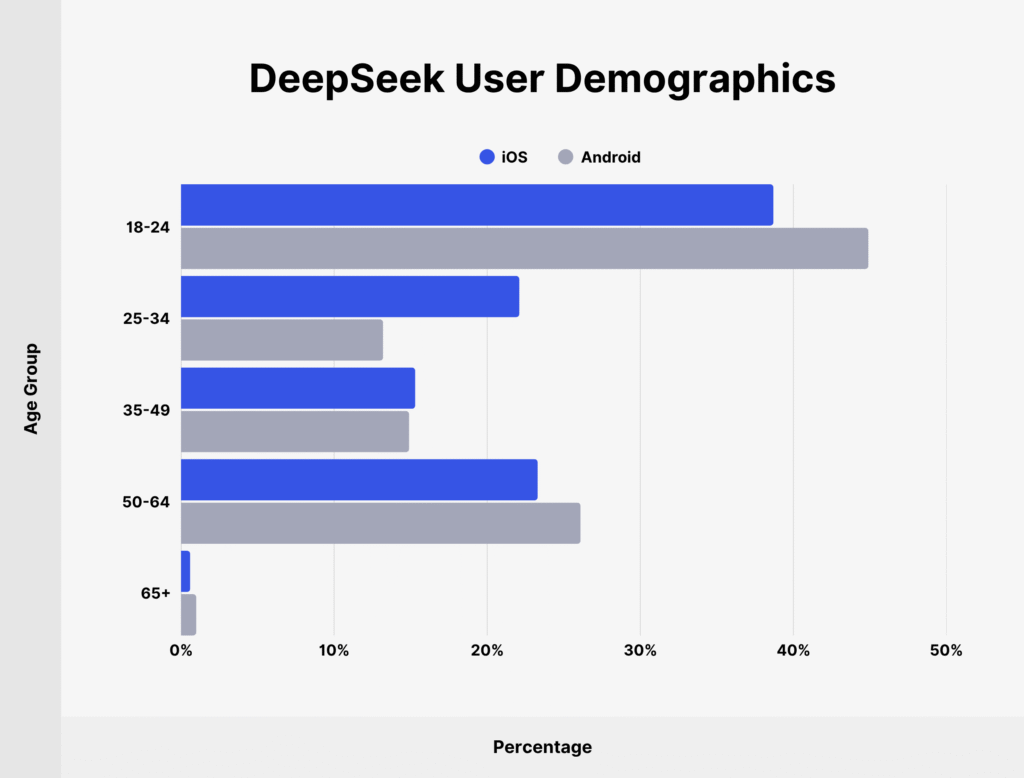
Recent Developments
- In May 2025, DeepSeek launched DeepSeek-Govern, a model designed for legal reasoning and regulatory compliance automation.
- DeepSeek-Coder V2.1 introduced function reasoning with up to 25% improved refactoring capability over its previous version.
- The new PromptFlow IDE plugin supports real-time prompt optimization for Visual Studio Code and JetBrains editors.
- A strategic alliance with Hugging Face allows one-click deployment of DeepSeek models to over 40 cloud regions.
- DeepSeek-VL now integrates video, image, and document embeddings into a single API, available to developers since March 2025.
- The company rolled out privacy-preserving inference for healthcare deployments in the US and EU under HIPAA/GDPR standards.
- A multi-modal AI assistant for customer support, DeepSeek-Support, was launched and already powers 7 million monthly chats.
- New synthetic training datasets like SimPrompt-5M and RealCodePairs are now publicly available for community use.
- DeepSeek announced the opening of its first European R&D lab in Zurich, focusing on model alignment and safety.
- The CEO’s public roadmap confirms DeepSeek-XL, a 70B-parameter foundation model, is set to release in late 2025.
Conclusion
DeepSeek AI’s journey from a promising open-source initiative to a global leader in language and multimodal intelligence has been nothing short of transformative. Its exponential user growth, strong academic footprint, and enterprise-grade product lines underscore a mission driven by transparency, usability, and global reach. With 2025 marking major product releases, cutting-edge benchmarks, and open-access initiatives, DeepSeek has cemented its place at the forefront of next-generation AI.
Sources
- https://www.statista.com/statistics/1561128/deepseek-daily-active-users/
- https://www.techtarget.com/whatis/feature/DeepSeek-explained-Everything-you-need-to-know
- https://www.statista.com/topics/13177/deepseek/
- https://www.weforum.org/stories/2025/02/china-deepseek-shakes-up-ai-tech-stories/
- https://hbr.org/2025/02/what-deepseek-signals-about-where-ai-is-headed
- https://www.statista.com/statistics/1552824/deepseek-performance-of-deepseek-r1-compared-to-open-ai-by-benchmark/
- https://edition.cnn.com/2025/01/27/tech/deepseek-ai-explainer






